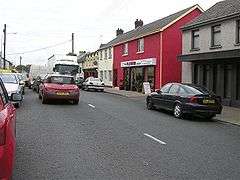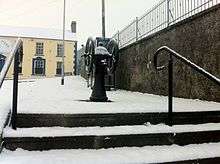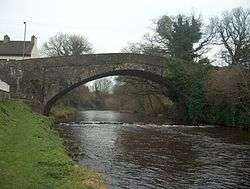Castledawson
Castledawson
| |
|---|---|
 Castledawson Main Street | |
 Castledawson shown within Northern Ireland | |
| Population | 3,293 (2001 Census) |
| • Belfast | 35 mi (56 km) |
| District | |
| County | |
| Country | Northern Ireland |
| Sovereign state | United Kingdom |
| Post town | MAGHERAFELT |
| Postcode district | BT45 |
| Dialling code | 028 |
| Police | Northern Ireland |
| Fire | Northern Ireland |
| Ambulance | Northern Ireland |
| EU Parliament | Northern Ireland |
| UK Parliament | |
| NI Assembly | |
Castledawson is a village in County Londonderry, Northern Ireland. It is mostly within the townland of Shanemullagh (from Irish an Seanmhullach, meaning 'the old hilltop'),[1] about four miles from the north-western shore of Lough Neagh, and near the market town of Magherafelt. At the 2011 Census it had a population of 3,293.

History
The village sits on the River Moyola and was originally called "Dawson's Bridge". The bridge that crossed the river here was once the largest single span stone bridge in Ireland. The village was named after its 'castle' (actually a large manor house) built by Joshua Dawson in 1713. He was Chief Secretary for Ireland and founded the village in 1710. The Dawson estate, Shanemullagh, shares its name with the original townland name. The Dawson family also founded Christ Church, on the edge of that estate, in the early 18th century.
On 12 July 1830, Orange Institution parades led to confrontations between Orangemen and Ribbonmen in Maghera and Castledawson. Several Catholic homes were then burnt by Protestants following these clashes.[2]
On 29 June 1912, a large group of Ancient Order of Hibernians members, allegedly drunk after having held a parade, clashed with a party of Presbyterian Sunday School children in Castledawson, who were returning from their annual excursion, in what became known as the Castledawson Incident. The prominent Presbyterian reverend James Armour laid the blame for the incident on alcohol and "the mad Orangemen of the locality," whom he believed may have set up the incident. The response to this incident saw rioting in Belfast that resulted in roughly 2,000 Catholic shipyard workers and 500 Protestant Home Rulers being violently driven from their jobs at the Workman and Clarke shipyard.[3]
Castledawson was the hub of the mid Ulster shirt-making industry, with its location midway between Belfast and Derry being crucial. In 1943, Nestlé built and opened a factory that made sweetened condensed milk. However, it was closed in the 1970s. Today it is the home of the award-winning Ditty's Bakery and Moyola Precision Engineering, a noted innovator of aerospace components.
The River Moyola, which dissects the village, is popular with anglers and has managed stocks of salmon (but also has perch, eel, trout and bream). Dominating the horizon to the south-west of the village is a dramatic ráth.

People

Famous natives have included:
- James Chichester-Clark, a direct descendant of the Dawsons, who was the Prime Minister of Northern Ireland from 1969 to 1971.
- The poet Seamus Heaney, who was awarded the 1995 Nobel Prize in Literature, was born at a farm near Castledawson in 1939, and was brought up in the nearby village of Bellaghy.
- Marian Donnelly, former President of the Workers' Party, was born in Castledawson in 1938.
- The singer-songwriter and producer Ciaran Gribbin.
Transport
Castledawson railway station opened on 10 November 1856, closed for passenger traffic on 28 August 1950, and finally closed altogether on 1 October 1959.[4]
The main A6 Belfast to Derry road passed through Castledawson from 1971, when the nearby Castledawson roundabout was built, in anticipation of the completion of the M22, which was never forthcoming, until 1992, when it was finally bypassed by a single-carriageway A6 upgrade. This section is currently being dualled, marking the end of a 47-year wait for the high-quality bypass it was promised, all those decades ago.
Education
- Castledawson Primary School
- New Row Primary School
Sport
Castledawson is home to the association football club Moyola Park, the Gaelic Athletic Association club St Malachys G.A.C. Castledawson and the eighteen hole Moyola golf club.
2011 Census
According to the 2011 Census, Castledawson has 3,329 residents. 53.44% of the Castledawson ward were Catholic, while 43.47% were Protestant.[5]
In terms of National Identity, 8 choices were provided and the breakdown is as follows[6]
| Northern Ireland Census 2011 | |
| National Identity | % |
|---|---|
| British only | 38.45% |
| Irish only | 27.04% |
| Northern Irish only | 24.48% |
| British and Irish only | 0.27% |
| British and Northern Irish only | 4.18% |
| Irish and Northern Irish only | 2.01% |
| British, Irish and Northern Irish only | 0.39% |
| Other | 3.18% |
References
- ↑ Placenames NI Archived 2012-03-31 at the Wayback Machine.
- ↑ "Parades and Marches - Chronology 2: Historical Dates and Events". Conflict Archive on the Internet (CAIN). Retrieved 28 January 2010.
- ↑ McGaughey, Jane G. V. (9 March 2012). "Ulster's Men: Protestant Unionist Masculinities and Militarization in the North of Ireland, 1912-1923". McGill-Queen's Press - MQUP. pp. 53–4. Retrieved 24 February 2018.
- ↑ "Castledawson station" (PDF). Railscot - Irish Railways. Retrieved 2007-09-15.
- ↑ 2011 Census for Northern Ireland
- ↑ Culture Northern Ireland
| Wikimedia Commons has media related to Castledawson. |
